QuestionThank you Chrys!
I figured that the mom must be feeding because the oldest one was alive for 4-4.5 days. It couldnt have lived for that long without food right?
Some of the research I found about ensuring they are fed, said that you can see the food inside their crop, is this true? Also, if we handfeed, I read that we must continue to handfeed all the time. Can we put them back in the nest after we feed them, or is it that if the mom didnt feed once, she will continue not to feed, must we keep them in a seperate home? I guess what Im asking is do we have to hand-feed each and every time, or will it just depend on if we see food in their bellies?
Im nervous to handfeed, any good tips for it? I have found some research online about handfeeding and will follow this. Im sorry for writing so much. I feel that you are a better resource than the books I have and the online research because most of that is very conflicted. I don't know which "expert" is right. I have been busily reading everyday about breeding the keets, please dont think I just jumped into breeding them. Our keets are 3 years old and this is their first clutch. I just want to ensure I have done as much as I possibly can. Thank you for your time and knowledge, sincerely!
Krystal heikes
-------------------------------------------
The text above is a follow-up to ...
-----Question-----
Hi Chris,
How are you? I wrote to you a couple weeks ago regarding nesting material. My female parakeet finally laid 6 eggs and they started hatching Thursday night/Friday morning (2/8-9). So far there has been 3 hatched. I saw the first 2. But the third I never got to see because the mom wouldnt leave the nest. The third one hatched yesterday morning. I got home from work tonight and peeked inside to find the oldest not moving even though the mom was still on her. So I shooed out the mom and took out the nest and I only saw 1 dead (the oldest) and 1 alive (the 2nd). We found the third one or newest one buried under some shavings, dead.
The youngest one seemed like it wasnt fully developed, it looked like it didnt live long (well it was only born on Sunday) But the biggest one didnt seem like anything was wrong with it (as far as cause of death). The parents are showing no signs of hurting them, they are perfect parents, I think. How can we tell if they arent being fed? Also, is the mom supposed to keep sitting on her babies after they are hatched because she has been, I was afraid maybe she suffocated it. Im so sad. It has been the most beautiful thing to watch, this process, and I did so much research, I thought I did everything I should. Is there anything you can suggest. Im afraid for the other baby and the 3 other eggs.
Thank you for your time, it means SO much.
Thanks again
Krystal Heikes
-----Answer-----
Hi, Krystal.
I'm sorry about the babies dying. So many things can go wrong from the time an egg is fertilized until the babies grow up that there's not enough room here to list all the possibilities. Babies can have problems developing inside the egg, they can conceive illness inside the egg, they can die during hatching, etc., etc., etc. This is why birds, as well as other animals, produce so many offspring at a time...high mortality rates.
The female keet should keep all the babies crops full most of the time. If a female doesn't feed a baby, most likely something is wrong with the baby...a female will know this long before you will. In order to tell if the babies are being fed, look at their crops. The crop is the area just below the neck where the bird's chest is located...it should be sticking out full of food when the babies are full. If you consistently see a baby without a full crop, the baby isn't being fed, and you'll need to pull this baby for handfeeding or handfeed it and then put it back with the parents. You can see and feel the crop to see if the babies are being handfed. Sometimes what happens when there is a full clutch of babies, the younger babies don't get fed as much as they need, so you have to help feed them by handfeeding them. With a large clutch like this, I will usually pull the oldest 2 birds completely and handfeed them, while the parents care for the younger babies. After about a week, I'll pull the rest for handfeeding.
Yes, the mom has to sit on them in order to keep them warm until they have enough feathers to keep themselves warm. Also, the warmth is necessary for the babies to metabolize their food. She isn't suffocating them.
This is why it is so important for those who own parrots and want to breed them to learn all they can about the entire process BEFORE allowing their birds to breed because of all the things that can go wrong.
There isn't anything you can do about babies dying soon after hatching if it's developmental in nature. You can help feeding them if this is a problem with so many babies. You do have a responsibility to be knowledgeable enough about all this and to feed your birds well in order for them to be healthy enough to mate and raise healthy babies if this is what you want to do. In order to have healthy babies, you have to start with healthy parents. Your adult birds seem to be doing everything right by your post. You'll just have to wait and see what happens with the other baby and the 3 other eggs.
Chrys
AnswerHi again, Krystal.
I understand completely about conflicting information in books and/or internet, etc.! This is why people like me like to be "experts" on this site. A lot of information in books is outdated, so be careful about this. Some websites are set up by people who are very knowledgeable, some are even bird vets, breeders, etc., with lots of experience. However, some are people who think they know a lot about birds, but don't really. You just have to take in everything you can and from your own experiences, sites like this, etc., use common sense. Birds aren't complicated...most of it is just common sense. Subscribe to magazines, like Bird Talk, which have more up to date information. Log on to www.drsfostersmith.com and sign up to get their bird catalog...it's not just a catalog...there are excellent articles in it, too, about how to care for birds. www.birdchannel.com is a good site and so is the BirdsNWays site. Learn about things such as good human nutrition (same applies to birds), bird anatomy, general first aid (applies to birds, too), try to learn about different types of avian diseases/illnesses and symptoms, it also helps to learn about bacteria, viruses, yeast/fungi. These will help you care for your birds properly and know what to do when an emergency/serious situation crops up. Make yourself a birdie first aid kit, too...you'll need it when raising birds. Now to your questions....
Babies can live for the first 24-48 hours on their yolk sac (the egg yolk)...it nourishes the baby while it's in the egg. The baby absorbes the egg sac into it's navel just before it hatches out. If a baby hatches without first absorbing it's egg sac, it will die. So, the 1st baby could have survived off the sac. Yes, it's true...you can see the food in the crop. This is why you need to examine the babies to see if food is in their crops so you can determine if mom is feeding them. You need to check each baby at least once per day.
Handfeeding - You can pull the babies completely from the parents when they are about 10 days old and handfeed them (they would have to be kept in a brooder of some type)...this is what most breeders do in order to have very tame babies for customers (the babies imprint on humans instead of their parents). OR you can help the parents with their babies by handfeeding them and placing them back in the nesting box after being fed. The babies may or may not be tame enough to be pets when they wean if they are fed this way.
You should be nervous to handfeed! A baby bird can be killed if the human doesn't have any idea what they are doing. However, you can't just let the babies die. Handfeeding is really easy, but you have to know how to do it so you don't do something wrong. There's many descriptions on the internet of how to handfeed and my website has directions. The most important things are you have to make sure the handfeeding formula is the right temperature when FED to the babies but not too hot (too hot will burn crop from inside out), feed enough but don't overfeed (you can see the food in the crop to know how much is enough but you get used to this after a few feedings), feed right to left with baby facing you, be sure you get a feeding response from the baby before starting to feed (or baby could aspirate), and feed slowly (don't "shoot" the entire syringe of food down throat all at once).
Actually, I prefer handfeeding parakeets to most other parrots because they are very eager to eat (after the first time or two...it takes a couple times for them to get used to being handfed), which makes them easy to handfeed (even though they are small).
Come back with any more questions. That's why we're here!
Chrys

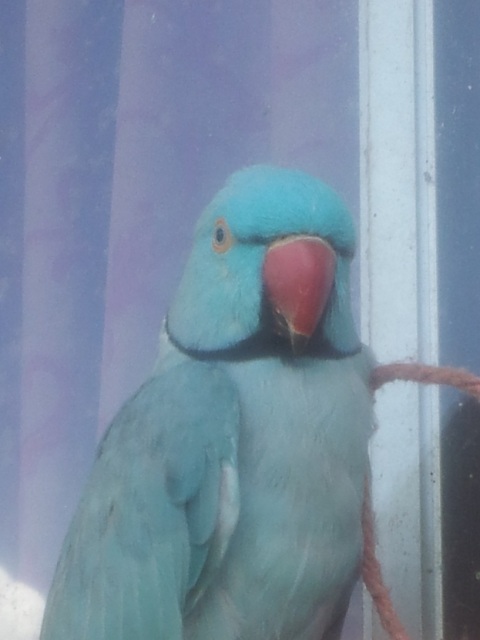 RE: Indian Ringneck probems
Question
Indy our Ringneck
Thank you for your he
RE: Indian Ringneck probems
Question
Indy our Ringneck
Thank you for your he
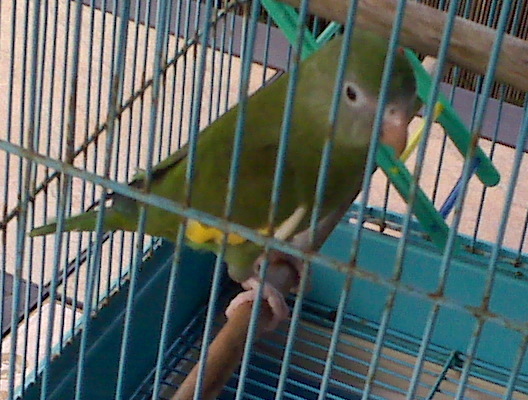 What type of parrot is this?
Question
Friendly bird
A week ago ths small parrot flew
What type of parrot is this?
Question
Friendly bird
A week ago ths small parrot flew
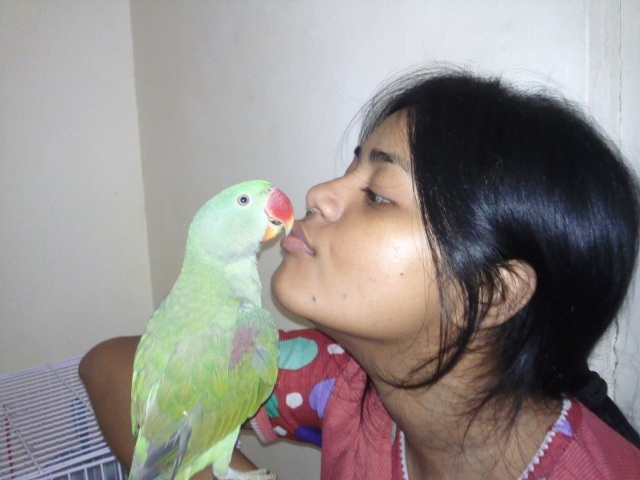 can i give my parrot chole(chana) called in hindi
Question
my little chaddi alexa
dear sir,
can give chan
can i give my parrot chole(chana) called in hindi
Question
my little chaddi alexa
dear sir,
can give chan
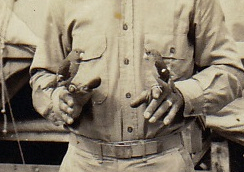 ID Birds
Question
Panama Birds
My uncle served in Panama in 1941
ID Birds
Question
Panama Birds
My uncle served in Panama in 1941
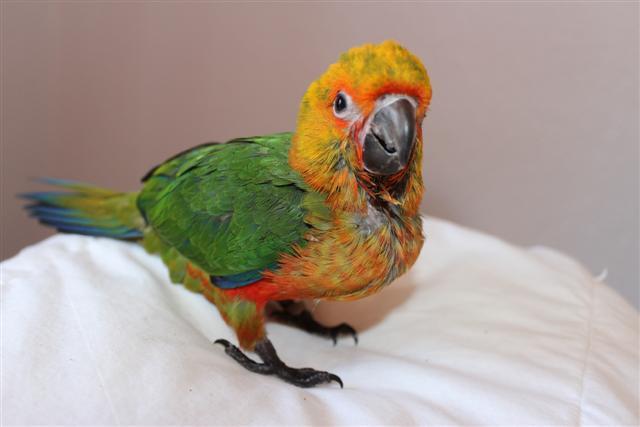 Jenday Conure Weaning?
Question
Castor the Conure
Hi
I have a 9 week o
Jenday Conure Weaning?
Question
Castor the Conure
Hi
I have a 9 week o